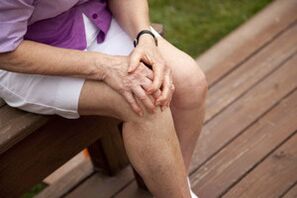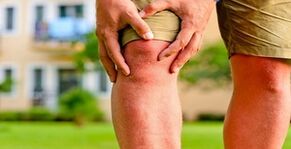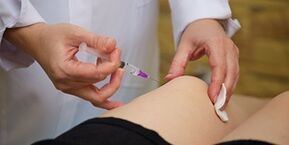
Many people complain of pains that occur in the knee.This may indicate the onset of the development of various diseases.The most common pathology that affects the knee joints is arthrosis, which is popularly called the deposition of salts.
Absolute arthrosis leads to the complete destruction of the cartilage and the exposure of the bone, as well as to the formation of osteophytes and complete deformation of the joint.This disease can turn a person into a disabled person.We will try to figure out what these are the disease, what are its symptoms and methods of treatment.
What is arthrosis of the knee joint
The large berets and femoral bone in the knee joint of a person are covered with articular cartilage.There is also a second type of cartilage, which forms menis, acting as shock absorbers or layers.
The articular fluid provides smooth movement and additional protection.The development of arthrosis occurs when it begins Carrying tissue is damaged, protecting the bones, as a result of which their surface is exposed, and the production of articular lubrication gradually decreases.At the same time, both partial cartridges and complete loss can occur.
The manifestation of deforming arthrosis of the knee joint is accompanied by the destruction of its cartilage shells, and after some time the bones and ligaments located nearby can be drawn into the process.As a result of loss of cartilage occurs Flip increase, and the joint is deformed.
Sometimes from the outside you can even feel bone spurs, which are a pathological growth of bones.As it happens Deformation of the surface of the bones, and they can no longer close, as expected, then a person has a limitation of movements.
This condition is accompanied by pain.It manifests itself especially in the morning, when a person after prolonged immobility begins to move.In the end, this significantly reduces the quality of life.
Causes of the disease

What does this disease arise?Doctors identify several reasons:
- aging and wear of the cartilage;
- injury;
- overweight;
- age -related changes;
- Autoimmune diseases.
In the latter case, immunity begins to attack its own articular fabric, which leads to its inflammation and destruction.An example is a disease such as rheumatoid arthritis, in which simultaneous damage to both joints occurs and disability develops.
Also, the reason for the deformation of the cartilage can be called insufficient blood supply The heads of the femur.In this case, we are talking about aseptic necrosis.The degeneration of the knee joint and the displacement of the mechanical axis can occur due to the improper formation of the knee joint in early childhood.
Symptoms of the disease
Arthrosis of the knee joint is characterized by three stages of development.The first stage is manifested by weak pain, unpleasant sensations in a sore spot and periodically emerging swelling.
In the second stage, the symptoms begin to intensify, a crunch appears, and movements become limited.Arthrosis of the knee joint of the third degree is accompanied constant painful sensations, while the cartilage fabric is practically destroyed.
Symptoms of arthrosis of the knee joint are usually manifested by pain.It can occur suddenly, but basically its development occurs slowly.A person begins to notice her in the morning, immediately after awakening.Knee pain occurs when walking up the stairs, and often When walking.When changing weather in meteo -sensitive people, pain in the knee joint is also observed.
Another symptom of arthrosis The swelling is, which occurs as a result of inflammation, accumulation of excess fluid in the knee or may be associated with the formation of bone spurs.The skin in the affected place becomes red and hot to the touch.In case of chronic inflammation of the joints, pain and edema are removed using anti -inflammatory drugs.
In addition, the symptom of arthrosis is Loss of stability, when a person is simply not able to bend the leg in the knee or fully straighten it.The crunch that arises is explained by the fact that the amount of synovial lubrication decreases.Such a creaking sound, which appears later, cause bone spurs that, when driving, rub against each other.
During climbing the stairs or when performing physical exercises, there is limited movements.This makes many use a cane or walkers.
The deformation of the knee joint is a very terrible symptom of arthrosis, as it indicates that irreversible changes in the joint have occurred, making a person a disabled person.The knees can be turned out or turned inside to each other.

The principles of treatment
Having dealt with the common symptoms of the disease, it is necessary to understand how it is treated.First of all, it should be aimed at eliminating pain.
You need to know that taking painkillers only Only weakens the symptomsbut in no way affect the course of the disease and such drugs are not able to restore the damaged cartilage.
Treatment of arthrosis of the knee joint with drugs is carried out in the following ways:
- The use of non -steroidal anti -inflammatory drugs, with which pain relieves and reduce inflammation.
- The use of medicines that help restore cartilage.
- The use of ointments and creams from deforming arthrosis.
In some cases, surgical intervention is carried out, and also prescribe Physiotherapeutic procedures and physiotherapy exercises.Gymnastics with such a disease significantly helps in treatment, and the attending physician should select the exercises.
Currently, most drugs have Many side effects And with prolonged use, the functioning of organs and systems occurs.
Using non -steroidal drugs
Treatment of arthrosis of the knee joint is carried out by non -steroidal anti -inflammatory drugs.
They help relieve pain and reduce inflammation, but the long-term use of these drugs is prohibited, since the resulting side effects negatively affect the intestinal mucosa and stomach, as well as the liver, kidneys and cardiovascular system.
Despite the fact that taking these drugs is necessary for the treatment of arthrosis of the knee joint, however, they are able to reduce the production of proteoglycans, and thus dehydrate cartilage tissue.That is why such funds should be takenstrictly according to a doctor's prescription And only under his control.
For prolonged use, experts advise choosing Selective anti -inflammatory drugs, which have fewer side effects and do not have a negative effect on metabolism in cartilage.
Carbon recovery preparations
For nutrition and restoration of cartilage, a constant intake to its fabrics is necessaryChondroprotectors.These substances are very important for people suffering from arthrosis of the knee joint.
The positive effect of their reception appears only after use for a rather long time (at least six months).Chondroprotectors improve the quantity and quality of synovial fluid, as well as contribute to restoration cartilage plate.
But, despite such beneficial properties of these compounds, they should not be considered as fixed assets for the treatment of arthrosis of the knee joint.For this purpose, drugs must be taken for at least one and a half years, while they are not able to completely restore the destroyed cartilage.
Using creams, ointments and compresses
Treatment of arthrosis of the knee joint provides for the use of various ointments and creams.But such drugs should be considered only as an addition to the use of non -steroidal anti -inflammatory drugs and Chondroproprotectors.Ointments and creams help reduce discomfort, swelling, pain, improve joint mobility.
This effect is explained by the fact that these products penetrate through the skin into the blood, thereby improving blood circulation in the joint, accelerating metabolism in cartilage and restoring it.
Compress treatment.A much greater effect, compared to ointments, bring therapeutic compresses.For these purposes, a tool is often prescribed, which penetrates the fabric well and has an analgesic and anti -inflammatory effect.

The use of injections
The synovial liquid of the knee joint is very viscous, so that the fabrics do not rub against each other.An important component of such lubrication is hyaluronic acid, connecting proteoglycans to normalize the structure of cartilage tissue.
The level of this compound in the synovial fluid in patients with arthrosis is reduced quite strongly, due to which this lubricant becomes less viscous, and friction is enhanced.
Injections of drugs Based on hyaluronic acid, carried out in the knee, slows down the progression of the disease, but only half of patients with a diagnosis of arthrosis are reduced to a decrease in the manifestation of symptoms.The course of injections is usually carried out for three weeks, and one injection is done every seven days.Six months later, this procedure is carried out again.
Surgical treatment of arthrosis of the knee joint
If therapeutic treatment has not brought the proper effect, surgery is carried out.
It is also carried out if irreversible changes have already occurred in the knee joint.
Surgical treatment is of two types:
- Arthrodesis.
- Prosthetics.
With arthrodesis, the joint is immobilized, due to which the pain is eliminated.Prosthetics is a more modern method, which consists in the fact that with the help of special prostheses, a complete or partial Replacement of the damaged joint.
Thus, arthrosis of the knee joint is a disease insidious of its consequences, since a person can become a disabled person.It can be avoided if you eat right, lead a healthy lifestyle And control your weight.Thanks to such simple rules, you can never know about the existence of arthrosis of the knee joint.





















